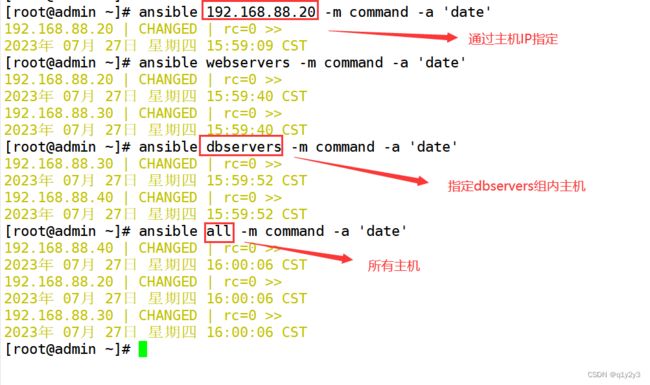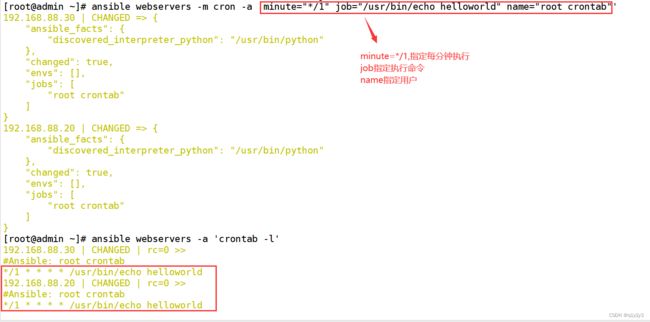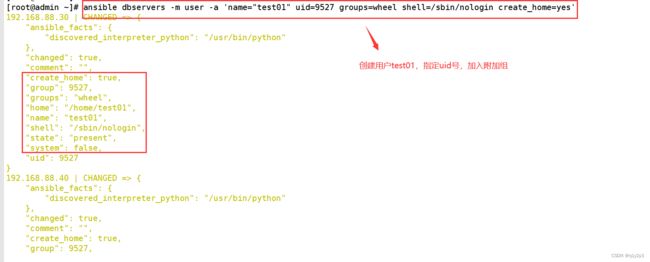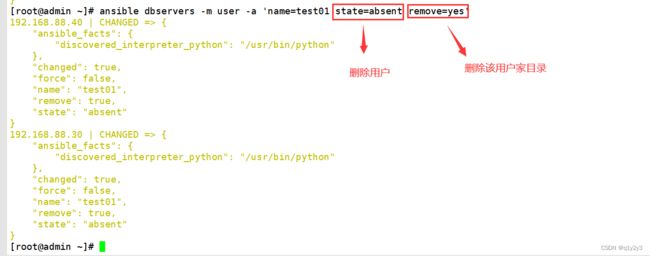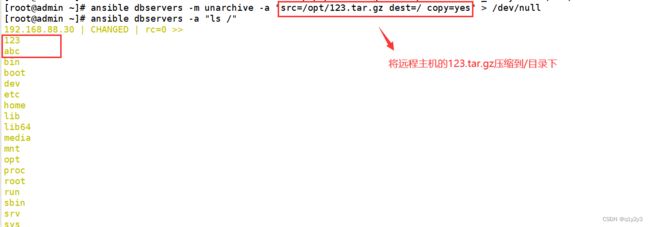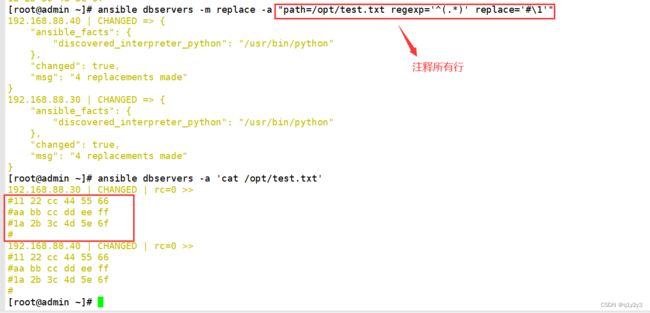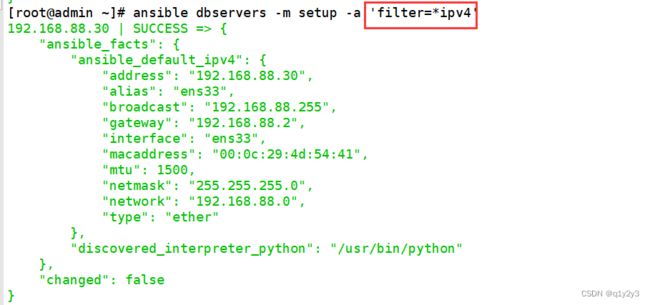Ansible 自动化运维工具
目录
一、概述
1.ansible 简介
2.ansible 特性
3.ansible 架构
二、ansible 环境安装部署
1.管理端安装 ansible(192.168.88.10)
2. ansible 工作目录
3. 配置主机清单
4.配置密钥对验证
三、ansible 命令行模块
1.command 模块
2.shell 模块
3.cron 模块
4.user 模块
5.group 模块
6. copy 模块
7.file 模块
8.hostname 模块
9.ping 模块
10.yum 模块
11.service/systemd 模块
12.script 模块
13.mount 模块
14.archive 模块
15.unarchive 模块
16. replace 模块
17.setup 模块
四、inventory 主机清单
1.如果是名称类似的主机,可以使用列表的方式标识各个主机。
2.inventory 中的变量
2.1主机变量
2.2组变量
2.3组嵌套
一、概述
1.ansible 简介
- Ansible是一个基于Python开发的配置管理和应用部署工具,现在也在自动化管理领域大放异彩。它融合了众多老牌运维工具的优点,Pubbet和Saltstack能实现的功能,Ansible基本上都可以实现。
- Ansible能批量配置、部署、管理上千台主机。比如以前需要切换到每个主机上执行的一或多个操作,使用Ansible只需在固定的一台Ansible控制节点上去完成所有主机的操作。
- Ansible是基于模块工作的,它只是提供了一种运行框架,它本身没有完成任务的能力,真正执行操作的是Ansible的模块, 比如copy模块用于拷贝文件到远程主机上,service模块用于管理服务的启动、停止、重启等。
- Ansible其中一个比较鲜明的特性是Agentless,即无Agent的存在,它就像普通命令一样,并非C/S软件,也只需在某个作为控制节点的主机上安装一次Ansible即可,通常它基于ssh连接来控制远程主机,远程主机上不需要安装Ansible或其它额外的服务。
- 使用者在使用时,在服务器终端输入命令或者playbooks,会通过预定好的规则将playbook拆解为play,再组织成ansible可以识别的任务,调用模块和插件,根据主机清单通过SSH将临时文件发给远程的客户端执行并返回结果,执行结束后自动删除
- Ansible的另一个比较鲜明的特性是它的绝大多数模块都具备幂等性(idempotence)。所谓幂等性,指的是无论执行多少次同样的运算,结果都是相同的,即一条命令,任意多次执行所产生的影响均与一次执行的影响相同。比如执行 systemctl stop xxx 命令来停止服务,当发现要停止的目标服务已经处于停止状态,它什么也不会做, 所以多次停止的结果仍然是停止,不会改变结果,它是幂等的,而 systemctl restart xxx 是非幂等的。
- Ansible的很多模块在执行时都会先判断目标节点是否要执行任务,所以,可以放心大胆地让Ansible去执行任务,重复执行某个任务绝大多数时候不会产生任何副作用。
2.ansible 特性
- 部署简单,只需在主控端部署Ansible环境,被控端无需做任何操作;
- 默认使用SSH协议对设备进行管理;
- 基于模块工作的,可以通过模块实现在被控制节点上执行命令操作;
- 很多模块具有幂等性,可以实现多次模块操作的状态如果没有发生改变,则不会重复执行;
- 有大量常规运维操作模块,可实现日常绝大部分操作;
- 配置简单、功能强大、扩展性强;
- 支持API及自定义模块,可通过Python轻松扩展;
- 通过Playbooks来定制强大的配置、状态管理;
- 轻量级,无需在客户端安装agent,更新时,只需在操作机上进行一次更新即可;
- 提供一个功能强大、操作性强的Web管理界面和REST API接口——AWX平台。
3.ansible 架构
Inventory:Ansible 管理主机清单。Playbooks:“剧本”YAML格式文件,多个任务定义在一个文件中,定义主机需要调用哪些模块来完成的功能。Modules:Ansible 执行命令功能模块,多数为内置的核心模块,可自定义。Plugins:模块功能的扩展,如连接类型插件、循环插件、变量插件、过滤插件等,该功能不太常用。
二、ansible 环境安装部署
1.管理端安装 ansible(192.168.88.10)
#使用在线源安装epel源
yum install -y epel-release //先安装 epel 源
yum install -y ansible2. ansible 工作目录
cd /etc/ansible
ls
ansible.cfg hosts roles
ansible.cfg:ansible的配置文件
hosts:主机清单配置文件,用于存储需要管理的远程主机的相关信息
roles:公共角色目录3. 配置主机清单
cd /etc/ansible
vim hosts
[webservers] #配置祖名
192.168.88.20 #组内包含的被管理的主机IP地址或主机名(主机名需要先修改/etc/hosts文件)
192.168.88.30
[dbservers]
192.168.88.404.配置密钥对验证
ssh-keygen -t rsa -P '' -f ~/.ssh/id_rsa
vim /etc/ssh/ssh_config
修改35行
StrictHostKeyChecking no
yum install -y sshpass
sshpass -p '123456' ssh-copy-id [email protected]
sshpass -p '123456' ssh-copy-id [email protected]
sshpass -p '123456' ssh-copy-id [email protected] 三、ansible 命令行模块
命令格式:ansible <组名> -m <模块> -a <参数列表>
ansible-doc -l #列出所有已安装的模块,按q退出1.command 模块
//在远程主机执行命令,不支持管道,重定向等shell的特性。
ansible-doc -s command #-s 列出指定模块的描述信息和操作动作
ansible 192.168.88.20 -m command -a 'date' #指定 ip 执行 date
ansible webservers -m command -a 'date' #指定组执行 date
ansible dbservers -m command -a 'date'
ansible all -m command -a 'date' #all 代表所有 hosts 主机
ansible all -a 'ls /' #如省略 -m 模块,则默认运行 command 模块
//常用的参数:
chdir:在远程主机上运行命令前提前进入目录
creates:判断指定文件是否存在,如果存在,不执行后面的操作
removes:判断指定文件是否存在,如果存在,执行后面的操作
ansible all -m command -a "chdir=/home ls ./"2.shell 模块
//在远程主机执行命令,相当于调用远程主机的shell进程,然后在该shell下打开一个子shell运行命令(支持管道符号等功能)
ansible-doc -s shell
ansible dbservers -m shell -a 'echo 123456 | passwd --stdin test"'
ansible dbservers -m shell -a 'echo $(ifconfig ens33 | awk "NR==2 {print $2}") | cut -d " " -f2'
ansible dbservers -m shell -a 'echo $(ifconfig ens33 | awk "NR==2 {print \$2}")'3.cron 模块
//在远程主机定义任务计划。其中有两种状态(state):present表示添加(可以省略),absent表示移除。
ansible-doc -s cron #按 q 退出
//常用的参数:
minute/hour/day/month/weekday:分/时/日/月/周
job:任务计划要执行的命令
name:任务计划的名称
user:指定计划任务属于哪个用户,默认是root用户
ansible webservers -m cron -a 'minute="*/1" job="/usr/bin/echo helloworld" name="root crontab"'
ansible webservers -a 'crontab -l'
ansible webservers -m cron -a 'name="root crontab" state=absent'4.user 模块
//用户管理的模块
ansible-doc -s user
//常用的参数:
name:用户名,必选参数
state=present|absent:创建账号或者删除账号,present表示创建,absent表示删除
system=yes|no:是否为系统账号
uid:用户uid
group:用户基本组
groups: 用户所属附加组
shell:默认使用的shell
create_home=yse|no: 是否创建家目录
password:用户的密码,建议使用加密后的字符串
remove=yes|no:当state=absent时,是否删除用户的家目录
#创建用户test01
ansible dbservers -m user -a 'name="test01" uid=9527 groups=wheel shell=/sbin/nologin create_home=yes'
#创建用户密码
ansible dbservers -m user -a 'name=test01 password="123123"'
ansible dbservers -m command -a 'tail -1 /etc/shadow'
#删除用户test01,并删除家目录
ansible dbservers -m user -a 'name="test01" state=absent remove=test01'5.group 模块
//用户组管理的模块
ansible-doc -s group
#创建mysql组
ansible dbservers -m group -a 'name=mysql gid=306 system=yes'
ansible dbservers -a 'tail /etc/group'
#将test01用户添加到mysql组中
ansible dbservers -m user -a 'name=test01 uid=9527 system=yes group=mysql'
ansible dbservers -a 'tail /etc/passwd'
ansible dbservers -a 'id test01' 6. copy 模块
//用于复制指定主机文件到远程主机的
ansible-doc -s copy
//常用的参数:
dest:指出复制文件的目标及位置,使用绝对路径,如果源是目录,指目标也要是目录,如果目标文件已经存在会覆盖原有的内容
src:指出源文件的路径,可以使用相对路径或绝对路径,支持直接指定目录,如果源是目录则目标也要是目录
mode:指出复制时,目标文件的权限
owner:指出复制时,目标文件的属主
group:指出复制时,目标文件的属组
content:指出复制到目标主机上的内容,不能与src一起使用
ansible dbservers -m copy -a 'src=/etc/fstab dest=/opt/fstab.bak owner=test01 mode=600'
ansible dbservers -a 'ls -l /opt'
ansible dbservers -a 'cat /opt/fstab.bak'
ansible dbservers -m copy -a 'content="helloworld" dest=/opt/hello.txt' #将helloworld写入/opt/hello.txt文件中
ansible dbservers -a 'cat /opt/hello.txt' 7.file 模块
//设置文件属性
ansible-doc -s file
ansible dbservers -m file -a 'owner=test01 group=mysql mode=644 path=/opt/fstab.bak' #修改文件的属主属组权限等
ansible dbservers -m file -a 'path=/opt/fstab.link src=/opt/fstab.bak state=link' #设置/opt/fstab.link为/opt/fstab.bak的链接文件
ansible dbservers -m file -a "path=/opt/abc.txt state=touch" #创建一个文件
ansible dbservers -m file -a "path=/opt/abc.txt state=absent" #删除一个文件
8.hostname 模块
//用于管理远程主机上的主机名
ansible dbservers -m hostname -a "name=mysql01"9.ping 模块
//检测远程主机的连通性
ansible all -m ping10.yum 模块
//在远程主机上安装与卸载软件包
ansible-doc -s yum
ansible webservers -m yum -a 'name=httpd' #安装服务
ansible webservers -m yum -a 'name=httpd state=absent' #卸载服务11.service/systemd 模块
//用于管理远程主机上的管理服务的运行状态
ansible-doc -s service
//常用的参数:
name:被管理的服务名称
state=started|stopped|restarted:动作包含启动关闭或者重启
enabled=yes|no:表示是否设置该服务开机自启
runlevel:如果设定了enabled开机自启去,则要定义在哪些运行目标下自启动
ansible webservers -a 'systemctl status httpd' #查看web服务器httpd运行状态
ansible webservers -m service -a 'enabled=true name=httpd state=started' #启动httpd服务12.script 模块
//实现远程批量运行本地的 shell 脚本
ansible-doc -s script
vim test.sh
#!/bin/bash
echo "hello world" > /opt/script.txt
ansible webservers -m script -a 'test.sh'
ansible webservers -a 'cat /opt/script.txt'
vim test.sh
#!/bin/bash
echo $1 > /opt/test.txt
echo $2 >> /opt/test .txt
ansible dbservers -m script -a 'test.sh abc 123!13.mount 模块
//挂载文件系统
ansible-doc -s mount
//常用的参数:
src:定义挂载设备的路径
path:定义挂载到哪个目录,必须指定
fstype:指定挂载文件的系统类型,必须指定,xfs、iso9660、nfs...
opts:定义挂载的参数,defaults、rw、ro...
state:定义挂载的状态,mounted(进行挂载,修改/etc/fstab信息)、absent(永久性卸载,并修改 /etc/fstab信息)、unmounted(临时卸载,不修改/etc/fstab信息)
ansible dbservers -m mount -a 'src=/dev/sr0 path=/mnt state=mounted fstype=iso9660'
14.archive 模块
//打包压缩
ansible-doc -s archive
//常用的参数:
path: 必须参数,远程主机上需要被打包压缩的源文件/目录
dest: 打包压缩后的包文件路径(包文件的父目录必须存在);如果包文件已存在,则会被覆盖
format: 指定压缩类型,包括: bz2、gz(默认)、tar、xz、zip
remove=yes|no: 是否删除源文件
ansible dbservers -m archive -a "path=/etc/yum.repos.d/ dest=/opt/repo.zip format=zip"
ansible dbservers -m archive -a "path=/opt/123.txt,/opt/hello.txt dest=/opt/aaa.tar.gz format=gz remove=yes"
15.unarchive 模块
//解包解压缩
ansible-doc -s unarchive
//常用的参数:
copy:默认为 copy=yes ,拷贝的文件从 ansible 主机复制到远程主机,copy=no 表示在远程主机上寻找源文件解压
src:tar包源路径,可以是 ansible 主机上的路径,也可以是远程主机上的路径,如果是远程主机上的路径,则需设置 copy=no
dest:解压后文件的目标绝对路径
remote_src: 和 copy 功能一样且互斥,设置 remote_src=yes 表示文件在远程主机上,设置为 remote_src=no 表示文件在 ansible 主机上
#将 ansible 主机的压缩文件拷贝到到远程主机并解压,修改文件所属组和用户
ansible dbservers -m unarchive -a "src=/opt/123.tar.gz dest=/root copy=yes"
或者
ansible dbservers -m unarchive -a "src=/opt/123.tar.gz dest=/root remote_src=no"
#在远程主机解包
ansible dbservers -m unarchive -a "src=/opt/aaa.tar.gz dest=/root copy=no"
或者
ansible dbservers -m unarchive -a "src=/opt/aaa.tar.gz dest=/root remote_src=yes"16. replace 模块
//类似于sed命令,主要也是基于正则进行匹配和替换
ansible-doc -s replace
//常用的参数:
path:必须参数,指定要修改的文件
regexp:必须参数,指定一个正则表达式
replace:替换regexp参数匹配到的字符串
backup=yes|no: 修改源文件前创建一个包含时间戳信息的备份文件
before:如果指定,则仅替换/删除此匹配之前的内容,可以和after参数结合使用
after:如果指定,则仅替换/删除此匹配之后的内容,可以和before参数结合使用
owner:修改文件用户名
group:修改文件组名
mode:修改文件权限
vim /opt/test.txt
11 22 33 44 55 66
aa bb cc dd ee ff
1a 2b 3c 4d 5e 6f
#匹配 333 并修改为 ccc
ansible dbservers -m replace -a "path=/opt/test.txt regexp='33' replace='cc'"
#匹配到任意一个或多个开头的行增加注释
ansible dbservers -m replace -a "path=/opt/test.txt regexp='^(.*)' replace='#\1'"
#取消注释
ansible dbservers -m replace -a "path=/opt/test.txt regexp='^#(.*)' replace='\1'"
#匹配以 a 开头的后面有一个或者多个字符的行,并在前面添加 # 注释
ansible dbservers -m replace -a "path=/opt/test.txt regexp='^(a.*)' replace='#\1'"
ansible dbservers -m replace -a "path=/opt/test.txt regexp='3' replace='three' before=cc"
17.setup 模块
//facts 组件是用来收集被管理节点信息的,使用 setup 模块可以获取这些信息
ansible-doc -s setup
ansible webservers -m setup #获取mysql组主机的facts信息
ansible dbservers -m setup -a 'filter=*ipv4' #使用filter可以筛选指定的facts信息四、inventory 主机清单
Inventory支持对主机进行分组,每个组内可以定义多个主机,每个主机都可以定义在任何一个或多个主机组内。
1.如果是名称类似的主机,可以使用列表的方式标识各个主机。
vim /etc/ansible/hosts
[webservers]
192.168.80.11:2222 #冒号后定义远程连接端口,默认是 ssh 的 22 端口
192.168.80.1[2:5] #显示12-15的IP地址加入组中
[dbservers]
db-[a:f].web.com #用冒号指定字母范围,支持匹配a-f2.inventory 中的变量
Inventory变量名 含义
ansible_host ansible连接节点时的IP地址
ansible_port 连接对方的端口号,ssh连接时默认为22
ansible_user 连接对方主机时使用的用户名。不指定时,将使用执行ansible或ansible-playbook命令的用户
ansible_password 连接时的用户的ssh密码,仅在未使用密钥对验证的情况下有效
ansible_ssh_private_key_file 指定密钥认证ssh连接时的私钥文件
ansible_ssh_common_args 提供给ssh、sftp、scp命令的额外参数
ansible_become 允许进行权限提升
ansible_become_method 指定提升权限的方式,例如可使用sudo/su/runas等方式
ansible_become_user 提升为哪个用户的权限,默认提升为root
ansible_become_password 提升为指定用户权限时的密码2.1主机变量
[webservers]
192.168.80.11 ansible_port=22 ansible_user=root ansible_password=1234562.2组变量
[webservers:vars] #表示为 webservers 组内所有主机定义变量
ansible_user=root
ansible_password=123456
[all:vars] #表示为所有组内的所有主机定义变量
ansible_port=222.3组嵌套
[webservers]
192.168.88.20
192.168.88.30
[dbservers]
192.168.88.40
[webs:children] #表示为 webs 主机组中包含了 webservers 组和 dbservers 组内的所有主机
webservers
dbservers

